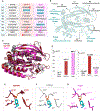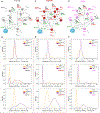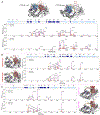Allostery in Protein Tyrosine Phosphatases is Enabled by Divergent Dynamics
- PMID: 38346324
- PMCID: PMC11144062
- DOI: 10.1021/acs.jcim.3c01615
Allostery in Protein Tyrosine Phosphatases is Enabled by Divergent Dynamics
Abstract
Dynamics-driven allostery provides important insights into the working mechanics of proteins, especially enzymes. In this study, we employ this paradigm to answer a basic question: in enzyme superfamilies, where the catalytic mechanism, active sites, and protein fold are conserved, what accounts for the difference in the catalytic prowess of the individual members? We show that when subtle changes in sequence do not translate to changes in structure, they do translate to changes in dynamics. We use sequentially diverse PTP1B, TbPTP1, and YopH as representatives of the conserved protein tyrosine phosphatase (PTP) superfamily. Using amino acid network analysis of group behavior (community analysis) and influential node dominance on networks (eigenvector centrality), we explain the dynamic basis of the catalytic variations seen between the three proteins. Importantly, we explain how a dynamics-based blueprint makes PTP1B amenable to allosteric control and how the same is abstracted in TbPTP1 and YopH.
Conflict of interest statement
Disclosure of potential conflicts of interest
No potential conflicts of interest were disclosed by authors.
Figures







Update of
-
Allostery in Protein Tyrosine Phosphatases is Enabled by Divergent Dynamics.bioRxiv [Preprint]. 2023 Jul 25:2023.07.23.550226. doi: 10.1101/2023.07.23.550226. bioRxiv. 2023. Update in: J Chem Inf Model. 2024 Feb 26;64(4):1331-1346. doi: 10.1021/acs.jcim.3c01615. PMID: 37547015 Free PMC article. Updated. Preprint.
Similar articles
-
Allostery in Protein Tyrosine Phosphatases is Enabled by Divergent Dynamics.bioRxiv [Preprint]. 2023 Jul 25:2023.07.23.550226. doi: 10.1101/2023.07.23.550226. bioRxiv. 2023. Update in: J Chem Inf Model. 2024 Feb 26;64(4):1331-1346. doi: 10.1021/acs.jcim.3c01615. PMID: 37547015 Free PMC article. Updated. Preprint.
-
A YopH PTP1B Chimera Shows the Importance of the WPD-Loop Sequence to the Activity, Structure, and Dynamics of Protein Tyrosine Phosphatases.Biochemistry. 2018 Sep 11;57(36):5315-5326. doi: 10.1021/acs.biochem.8b00663. Epub 2018 Aug 28. Biochemistry. 2018. PMID: 30110154
-
Evolutionarily Conserved Allosteric Communication in Protein Tyrosine Phosphatases.Biochemistry. 2018 Nov 13;57(45):6443-6451. doi: 10.1021/acs.biochem.8b00656. Epub 2018 Oct 26. Biochemistry. 2018. PMID: 30289703
-
Involvement of the small protein tyrosine phosphatases TC-PTP and PTP1B in signal transduction and diseases: from diabetes, obesity to cell cycle, and cancer.Biochim Biophys Acta. 2005 Dec 30;1754(1-2):108-17. doi: 10.1016/j.bbapap.2005.07.030. Epub 2005 Sep 12. Biochim Biophys Acta. 2005. PMID: 16198645 Review.
-
Cytoplasmic protein tyrosine phosphatases, regulation and function: the roles of PTP1B and TC-PTP.Curr Opin Cell Biol. 2005 Apr;17(2):203-9. doi: 10.1016/j.ceb.2005.02.001. Curr Opin Cell Biol. 2005. PMID: 15780598 Review.
Cited by
-
Orchestrating function: Concerted dynamics, allostery, and catalysis in protein tyrosine phosphatases.Curr Opin Struct Biol. 2025 Aug 1;94:103125. doi: 10.1016/j.sbi.2025.103125. Online ahead of print. Curr Opin Struct Biol. 2025. PMID: 40752367 Free PMC article. Review.
-
Mapping allosteric rewiring in related protein structures from collections of crystallographic multiconformer models.bioRxiv [Preprint]. 2025 May 27:2025.05.23.655529. doi: 10.1101/2025.05.23.655529. bioRxiv. 2025. PMID: 40501656 Free PMC article. Preprint.
-
Structures of human PTP1B variants reveal allosteric sites to target for weight loss therapy.bioRxiv [Preprint]. 2025 Mar 8:2024.08.05.603709. doi: 10.1101/2024.08.05.603709. bioRxiv. 2025. PMID: 39149290 Free PMC article. Preprint.
References
Publication types
MeSH terms
Substances
Grants and funding
LinkOut - more resources
Full Text Sources
Miscellaneous

